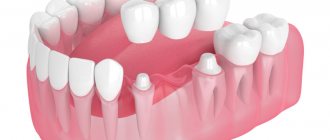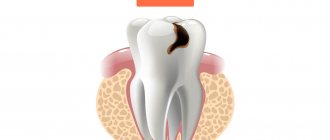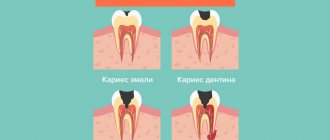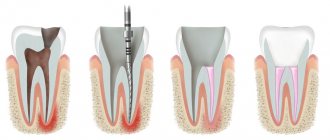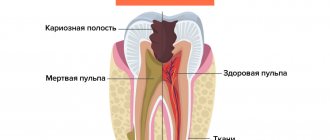Inflammation of the nerve of the tooth is characterized by:
- Pain from temperature stimuli;
- Very severe pain that radiates to the ear, temple or larynx;
- Night pain.
In the first stages, pain appears rarely and quickly subside, but as pulpitis develops, pain appears more often and more severely. The pain becomes more severe and throbbing when pulpitis becomes purulent.
When the first symptoms appear, you should immediately consult a doctor, because pulpitis is dangerous due to its complications. Treatment of pulpitis consists of removing the dental pulp (nerve) under anesthesia or using arsenic paste, mechanical and medicinal treatment of the canals, filling them and placing a filling, if necessary, using pins.
To perform high-quality work in root canals, qualified doctors at our center use modern treatment methods. The work is carried out with “four hands” (doctor-assistant), which improves the quality of the doctor’s work and the patient’s comfort.
Treatment of tooth pulpitis from 6,500 rubles.
Tooth pulpitis: symptoms, treatment
All you have to do is ignore the resulting caries and not contact the dentist in a timely manner, and after a while you will have to go to the dental clinic urgently.
Symptoms of inflammation of dental tissues:
- sudden sharp, throbbing pain, significantly worsening at night and radiating to the neck, ear, and other areas of the face;
- pronounced reaction to any stimulus (temperature, mechanical);
- the appearance of putrid odor from the mouth;
- change in enamel color;
- temperature increase.
Timely treatment of pulpitis of permanent teeth allows you to preserve the neurovascular bundle, which is necessary for the normal functioning of dental units, so if you experience any discomfort, contact your dentist!
What tools and equipment are used in our clinic?
First and most important
when treating tooth canals and treating pulpitis, this is an opportunity to quickly and effectively conduct an X-ray examination (radiovisiography). It is necessary for: making a correct diagnosis, determining the length and location of the canals, and monitoring the quality of their filling.
The advantage of a radiovisiograph is that the radiation exposure to the patient is 10–20 times less than when using a conventional X-ray machine.
Second
, the presence of an apex locator allows the doctor to know exactly in which part of the canal the instrument is located.
Third
, the presence of an endodontic motor allows you to work with advanced nickel-titanium instruments to expand and taper the canal. This allows you to efficiently clean and seal the canals.
Fourth
, the presence of optics allows the doctor to see the hidden mouths of the canals.
Fifth
, our clinic uses the latest advances in dentistry in canal treatment - three-dimensional obturation of root canals with hot thermoplasticized gutta-percha. During heating, gutta-percha becomes very plastic, due to which the tooth canal system is tightly sealed. This material is introduced on a special carrier made of a denser, modified gutta-percha - Gutta Core, preheated in a special oven. The tightness of the material virtually eliminates the risk of developing an infection in the tooth. Gutta-percha does not dissolve over time and does not irritate the tissue surrounding the tooth.
This method is very effective, it involves sealing and filling the entire system of lateral tubules, but it requires a highly qualified doctor and considerable financial and time costs.
Periodontitis
Enamel
Dentine
Pulp
Periodontitis (inflammation at the root apex)
Periodontitis is a process of inflammation that occurs in the bone tissue in the area of the tooth root. Infection from a carious cavity penetrates into the root canal, and from there enters the tissues surrounding the tooth root, destroying them. Periodontitis can have serous and purulent forms. If periodontitis occurs without pain, then the bone around the root of the tooth is reabsorbed, a granuloma appears (a sac at the apex of the root), which over time can turn into a cyst.
Dental granuloma is an inflammation of the periodontium, which is a small round-shaped formation located in the area of the tooth root. This disease, like a dental cyst, is characterized by a long asymptomatic course. Granuloma is aggravated under the influence of certain factors, which, as a rule, do not differ from the factors that cause exacerbation of dental cysts.
During therapeutic treatment, canals require filling not only to preserve the tooth, but also to prevent infection of the body as a result of the decay of dead tissue.
Acute periodontitis is manifested by sharp and severe pain in the tooth area, aggravated by touching it. There may be swelling of the lips, cheeks, bad breath, and sometimes fistulas on the gums. The tooth becomes mobile.
Chronic periodontitis develops slowly and does not cause characteristic pain. In the chronic form of periodontitis, the symptoms are less pronounced, but swelling and redness of the gums and increased temperature may occur. In some cases, a fistulous tract forms on the gum.
How is pulpitis and periodontitis treated?
Previously, pulpitis and periodontitis were direct indications for tooth extraction, but modern methods of dental treatment make it possible to save the tooth using dental canal filling technology.
Treatment begins with a dental examination - an x-ray showing the depth of the dental canals, the length of the nerves and their features. After diagnostic procedures and anesthesia, the tooth is “opened”—the pulp and tooth roots are removed. At this stage, the most important aspect of the dentist’s work is the complete, 100% removal of the tooth root, its small processes and dental tissue shavings.
After complete cleaning of the dental canals, the tooth is processed in order to completely sterilize the treatment area. Next, the dentist fills the dental canals with special pastes. It is extremely important to fill all the voids without leaving even a millimeter of free space. If there are voids, internal inflammation and the onset of disease may develop.
After filling the dental canals, a tooth augmentation procedure is performed. Modern materials make it possible to build up the removed dental tissue in full and match the shape and color. All of the above procedures take 40-60 minutes and do not require prior preparation or re-treatment. Filling of dental canals with tooth extension is an almost lifelong procedure, that is, it does not require repetitions or correction in the future.
Why is root canal filling better than tooth extraction?
- Most of the dental tissue, that is, the base of the tooth, is preserved;
- no deep intervention into the gum or bone is required;
- no need to install an implant;
- the restored tooth is indistinguishable from the real one and fully performs its functions;
- tooth extraction can cause tissue infection and complications;
- It is possible to save even “neglected” teeth.
Our Dentistry clinic on Shchelkovskaya “Diamed” performs filling of dental canals quickly and professionally. The clinic’s dentists have the necessary qualifications to carry out all the necessary stages of work, and only high-quality materials are used when filling. We are confident in the quality of our work, so you receive a guarantee on the installed seals. With our help, you will forget about tooth pain and will come to your dentist appointment with a smile. Just call us 8 (495) 033-00-63 or leave your details in the online registration form.
Treatment of periodontitis
In order to save a tooth with periodontitis, complex and lengthy professional treatment is necessary. In case of chronic periodontitis, the canal of the affected tooth is first treated: infected tissue is removed and the canal is disinfected. Then anti-inflammatory and antimicrobial medications are injected into the canal, and physiotherapeutic procedures are prescribed if necessary. To assess the success of treatment of such a tooth, a control radiovisiographic study is prescribed after 6 months. In very advanced forms of periodontitis, it is sometimes necessary to remove a tooth.
In case of acute periodontitis, the tooth is first left open for the outflow of inflammatory fluid and antibiotics are prescribed, and when the process subsides, treatment is continued according to the same scheme described above. Under X-ray control, root canals are filled using modern filling materials.
Depending on the degree of destruction, the tooth can be restored in different ways:
1. made of composite filling material directly in the mouth. With this type of tooth restoration, titanium or fiberglass pins are used to better fix the filling;
2. restore the missing part of the tooth using a post and a crown.
Treatment of periodontitis from 8,000 rubles.
Treatment
Treatment of caries consists of necrectomy (removal of softened tissue), preparation of hard tooth tissues to form a cavity, followed by filling.
Currently, light-curing composites are used for filling, which allow you to restore the tooth as aesthetically as possible.
All composites consist of an organic matrix and an inorganic filler. The physical properties of the filling material depend on the type of filler, its percentage, and particle size. There are hybrid composites - with large filler particle sizes. They are characterized by high strength and wear resistance, therefore they are used for filling chewing teeth. Another group - microfilled composites (with small particle sizes) - are highly polished and have good optical properties. They are used mainly for filling front teeth, where the load is somewhat less. To date, five generations of heliocomposites have appeared. They have become complex, that is, they combine the properties of both hybrid and micro-filled composites.
Thus, modern heliocomposites are both durable and aesthetic, which allows the dentist to restore the tooth layer by layer, using several shades of colors and masking the interface between the natural tissues of the tooth and the filling.
Pulpitis
- inflammation of the pulp, which is a direct complication of dental caries.
The pulp is a connective tissue formation containing blood and lymphatic vessels and nerves, and is located in the tooth cavity.
Since the pulp is located in a hard tissue chamber, when it is inflamed, the pressure inside increases greatly, which explains the intensity of pain in the initial forms of pulpitis, when the integrity of the chamber is preserved.
Treatment of dental cyst
A dental cyst is the last stage in the development of chronic periodontitis. It is a cavity of various sizes, which is formed in the thickness of the jaw and is connected to the root of the tooth. This cavity is lined with a membrane and filled with liquid. When microbes enter, the contents of the cyst suppurate. Usually the cyst grows for a long time without any subjective sensations or clinical manifestations. The first symptom that attracts attention is the deformation of the jaw in the form of a protrusion at the site of the growing cyst.
Tooth cyst
If the cyst does not suppurate, then it can reach a significant size without causing any reaction from the general condition of the patient and without causing him pain.
Types of cysts according to their causes:
- Eruption cyst – most often occurs in children aged 7 – 10 years.
- Paradental (retromolar) cyst - appears when there is difficulty in the eruption of a wisdom tooth and its chronic inflammation.
- A follicular (tooth-containing) cyst is formed due to infection of a tooth germ or an unerupted or supernumerary tooth.
- Primary cyst - is formed when the development of a tooth is disrupted from the remains of dental tissue.
- Radicular cyst - a cyst that forms on the root of a tooth and usually develops due to chronic periodontitis
- A residual cyst appears in the bone after tooth extraction.
Signs and symptoms of a dental cyst
Often the development of a cyst is completely asymptomatic or with barely noticeable symptoms: rare slight pain when biting on a tooth or mild pain when pressing on the gum. In this case, the cyst is detected completely by accident - on x-rays during the treatment of other teeth.
The main signs of a cyst begin to appear already at a late stage of development. Main symptoms of a cyst:
- Aching or nagging pain that only gets worse all the time. It is difficult to get rid of it with the help of simple analgesics and folk remedies. Initially, pain may occur when chewing on the causative tooth.
- The appearance of edema. When a cyst occurs, the gums around the diseased tooth become red and swollen.
- High temperature due to associated infection.
- Suppuration, flux and fistulous tract are external manifestations of an already formed cyst.
- X-rays and tomography are necessary to clarify the diagnosis.
Complications of pericoronitis
Purulent pericoronitis:
- Constant pain that intensifies when chewing;
- Pain radiating to the ear and temporal region;
- Increased body temperature up to 37.2 - 37.5°C;
- Mouth opening is limited and painful, which intensifies with the development of inflammation;
- The submandibular lymph nodes are enlarged and painful when pressed;
- When pressing on the hood, purulent contents are released from under it, causing sharp pain.
Acute pericoronitis can become chronic, when the inflammatory phenomena do not completely subside and exacerbations periodically occur.
Retromolar periostitis.
Occurs as a complication of purulent pericoronitis. The disease is characterized by clinical symptoms of purulent pericoronitis, but more pronounced.
- The pain intensifies;
- The general condition is disturbed, weakness and weakness appear;
- Body temperature rises to 38-38.5°C;
- Chewing food becomes impossible;
- Sleep is disturbed;
- The patient is pale, there is pronounced tissue swelling in the posterior part of the submandibular and lower part of the buccal region;
- The submandibular lymph nodes are enlarged and painful;
- When you press on the hood and surrounding tissues, a sharp pain occurs.
source site. www.dentalmir.ru
The best dentists in Sarov, where to treat teeth in Sarov
Why is a dental cyst dangerous? Consequences of the disease
A cyst that is not detected in time grows, which leads to the destruction of bone tissue and its replacement with connective tissue formations. As a rule, at this stage complications appear that lead to tooth loss. Possible complications with a dental cyst:
- Purulent inflammation of the cyst.
- Melting of the jaw bone due to cyst growth.
- Inflammation of the lymph nodes.
- The appearance of chronic sinusitis due to the growth of a cyst into the maxillary sinus.
- The appearance of osteomyelitis or periostitis.
- Formation of an abscess on the gum or cheek.
- Formation of phlegmon of the neck due to prolonged purulent inflammation.
- The development of sepsis - blood poisoning.
- Spontaneous fracture of the jaw, which appears due to the growth of the cyst and thinning of the bone.
Causes of caries development
The following reasons for the development of caries are identified:
- the presence of cariogenic microflora in the oral cavity;
- leftover food rich in carbohydrates;
- poor oral hygiene (soft plaque and tartar containing cariogenic flora);
- individual parameters of oral fluid, for example, saliva viscosity;
- genetic factor.
The mechanism of development of enamel demineralization (the release of calcium, fluorine, phosphorus ions from the enamel structure): cariogenic microorganisms (streptococcus sanguis, streptococcus mutans) are capable of fermenting carbohydrates to acids (in particular, lactic acid).
Further intake of carbohydrates leads to a local change in pH on the surface of the tooth enamel, reaching a critical level of 4.5 - 5.0. When a critical level of hydrogen ions is maintained for a long time, surface apatites dissolve in the least stable areas of the enamel (in the area of Retzius lines, interprismatic spaces), which leads to the penetration of acids into the subsurface layer of enamel and its demineralization. Less pronounced changes in the surface layer of enamel than in the deep layers are due to its structural features (the presence of a large amount of fluorapatites), as well as remineralization processes due to the constant supply of mineral components from the oral fluid. The continued formation of organic acids on the surface of the enamel leads to demineralization and a gradual increase in microspaces between the crystals of enamel prisms. As a result, conditions are created for the penetration of microorganisms into the formed microdefects.
Therapeutic treatment of cysts
If the size of the cyst does not exceed 8 millimeters, drug treatment is necessary. The entire treatment process takes place in several stages:
Opening of the causative tooth, instrumental and thorough medicinal treatment of the canals. The tooth canals are filled with medicinal paste, which has antimicrobial and anti-inflammatory effects. Periodically, the medicinal paste must be changed, so the tooth is opened again, and the cavity is filled with a new portion of medicinal paste. The number of repetitions depends on how successful the treatment is. The doctor monitors the condition of the cyst using x-rays.
- If the treatment is successful, as evidenced by a decrease in the size of the cyst, the dentist decides to permanently fill the canals and takes measures to restore the tooth.
- The process of further reduction of the cyst and regeneration of bone tissue is monitored for two years. To do this, it is necessary to take a photo every few months, since if the treatment is insufficiently effective, timely measures must be taken.
The only drawback of conservative therapy is its duration. During treatment, regular visits to the dentist are necessary, and further observation by the attending physician is necessary.



